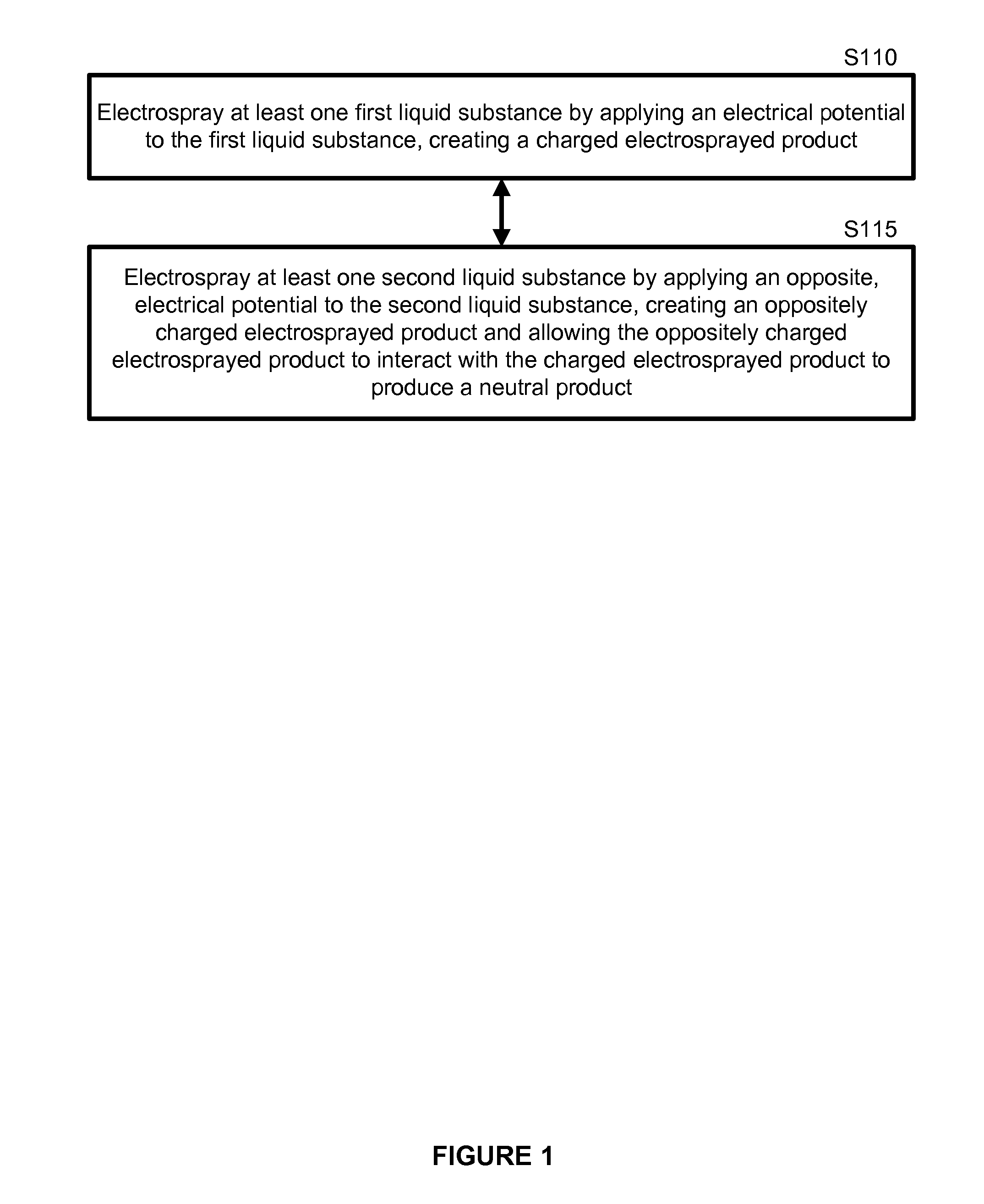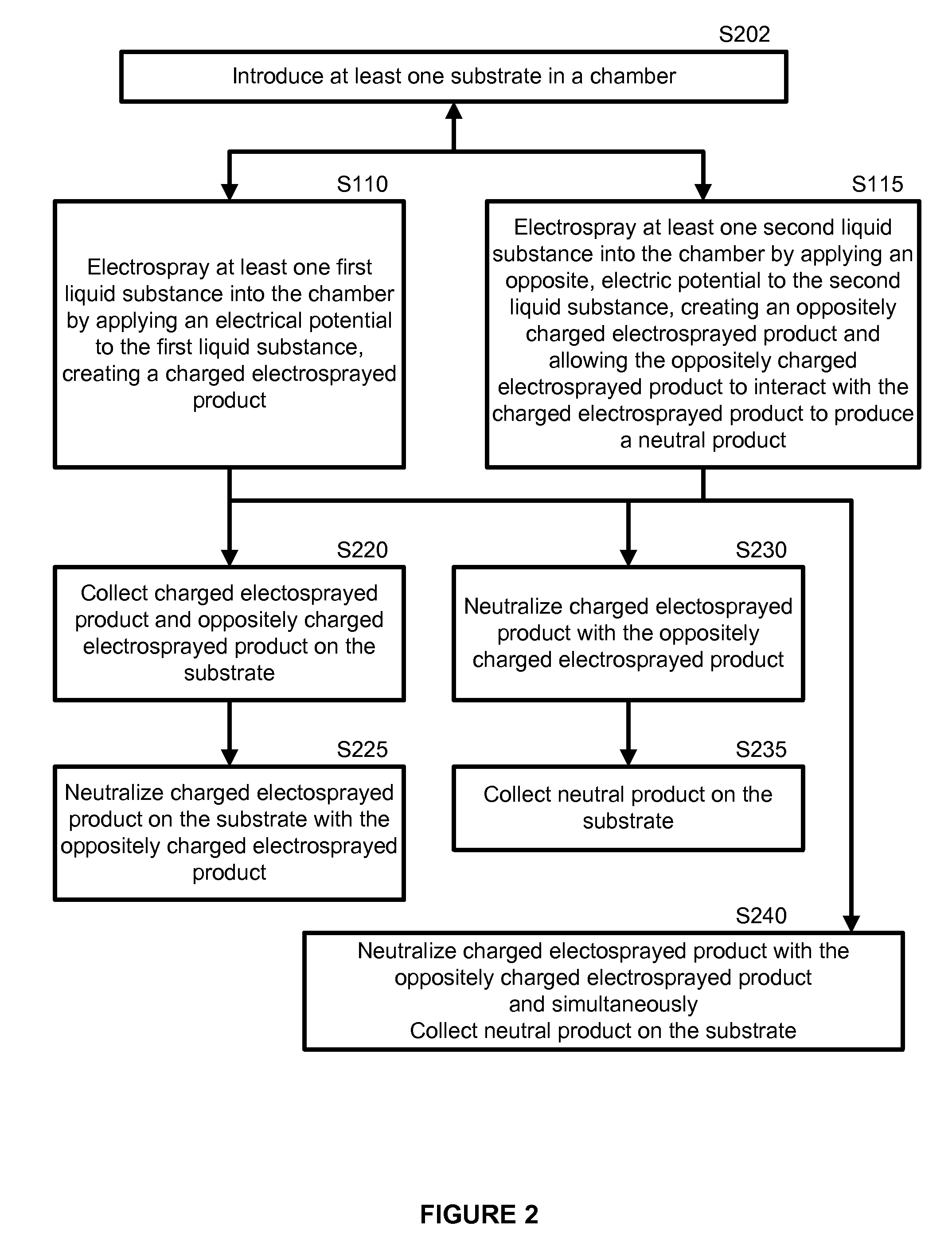Electrospray neutralization process and apparatus for generation of nano-aerosol and nano-structured materials
a technology of electrostatic neutralization and nano-structured materials, which is applied in the direction of separation of raw materials, filtration separation, and separation of processes, etc., can solve the problems of inability to apply the method of manufacturing nano-aerosols from most polymer and biological molecules, and the stability of highly charged aerosols created by es, and the currents in the atomizer and the neutralizing corona to control the neutralization have not been measured independently, so as to achieve low pri
- Summary
- Abstract
- Description
- Claims
- Application Information
AI Technical Summary
Benefits of technology
Problems solved by technology
Method used
Image
Examples
example 1
A. Example 1
Formation of a PVP Aerosol
[0240]In this example, 10 μL of 5% PVA solution in water was loaded into the capillary connected to the positive potential. A 50% ethanol solution was placed into the opposite capillary to neutralize the cloud of PVA particles. At a voltage of about 6-about 8 kV and a current of about 30-about 50 nA, an aerosol cloud was formed in seconds. The aerosol cloud was readily observed by passing a laser beam through the chamber. Unlike charged aerosol clouds, which disappeared in ˜2 to ˜5 sec after switching off the power, it was found that the neutral aerosol was still visible within the chamber up to about 10 to about 15 min after the voltage was disconnected. Such stability is a strong indicator of aerosol neutrality. In contrast to charged aerosols, particles in a neutral aerosol cloud are much less prone to interactions with chambers walls and are less likely to deposit there.
[0241]Since neutral aerosols decays in ˜10 min, one can estimate the sta...
example 2
B. Example 2
Deposition of Aerosol on Chamber Walls
[0243]In this example, 10 μL of 0.5% methylene blue dye in 50% ethanol was electrosprayed at the positive potential against negatively sprayed 50% glycerol at a voltage of about 6-about 9 kV and a current of about 0.7-about 1 μA. The glycerol droplets formed a readily visible aerosol. Approximately 1 mL of water was then placed into the chamber; the water was moved over the walls to collect the deposited dye. When the OD of the dye was measured at ˜608 nm relative to the wall area from which the aerosol was collected, it was found that about twice as much aerosol was deposited at the chamber bottom as compared to the top. Deposition on vertical walls was intermediate between the top and the bottom values. Such difference in deposition can be explained by the relatively large size of the aerosol (approximately more than 1 μm), which may be subjected to gravitational force.
example 3
C. Example 3
Formation of Molecular Nano-aerosol
[0244]In this example 0.05% PVP solution in water was electrosprayed from a positively charged capillary against pure ethanol electrosprayed from a negatively charged capillary. In contrast to the experiment described in Example 1, no visible aerosol was apparently seen upon illumination the chamber with a laser beam. However, freshly cleaved mica placed at the bottom of the chamber for ˜5 min was covered with dots at approximately 2.3±0.6 nm high, as seen in FIG. 37. The density of dots was about 10 particles per square μm. It was estimated that the height corresponds to a hemisphere comprising a single polymer molecule with an average mol. mass of 200 kDa. The average surface density of the nano-particles deposited on mica in T=5 min was measured as N=10 particles per square micron. With the diffusion coefficient expected for such particles in the air (D=˜10−3 cm2 / sec) and the thickness of an unstirred layer over mica surface (H=1 cm)...
PUM
| Property | Measurement | Unit |
|---|---|---|
| diameter | aaaaa | aaaaa |
| volumes | aaaaa | aaaaa |
| volumes | aaaaa | aaaaa |
Abstract
Description
Claims
Application Information
 Login to View More
Login to View More - R&D
- Intellectual Property
- Life Sciences
- Materials
- Tech Scout
- Unparalleled Data Quality
- Higher Quality Content
- 60% Fewer Hallucinations
Browse by: Latest US Patents, China's latest patents, Technical Efficacy Thesaurus, Application Domain, Technology Topic, Popular Technical Reports.
© 2025 PatSnap. All rights reserved.Legal|Privacy policy|Modern Slavery Act Transparency Statement|Sitemap|About US| Contact US: help@patsnap.com



